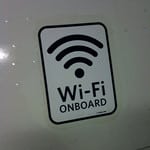Skift Take
Airlines must create a goal in delivering Wi-Fi: either subsidize a basic connection for all passengers and make money from higher ticket sales or offer a high-priced service to a limited number of business flyers.
It has been five years since American Airlines first launched Wi-Fi on its domestic flights in the U.S. and, frankly, since that time, Wi-Fi on airplanes is still stuck on the runway. It’s expensive, slow and based on GoGo data, less than 10 percent of flyers even attempt to use the service, even if someone else is paying for it.

Wi-Fi first showed up on flights five years ago and hasn’t really improved for the average passenger. Photo by Clintus McGintus.
So as entitled as we might feel to the same Wi-Fi experience in the air as we have on the ground, it’s not going to happen overnight. It’s going to cost more, have less capacity and come with limits. Don’t blame the airlines (or worse, the flight attendants): blame physics. After all, getting a mobile connection in a metal tube flying at a speed of 500 miles per hour is actually pretty freaking phenomenal.
Since network connectivity is the largest continuing cost of Wi-Fi on planes, it’s clear to see why the services are so expensive. It’s also why they are so slow.
The Daily Newsletter
Our daily coverage of the global travel industry. Written by editors and analysts from across Skift’s brands.
Have a confidential tip for Skift? Get in touch
Tags: in-flight, jetblue airways, wi-fi
